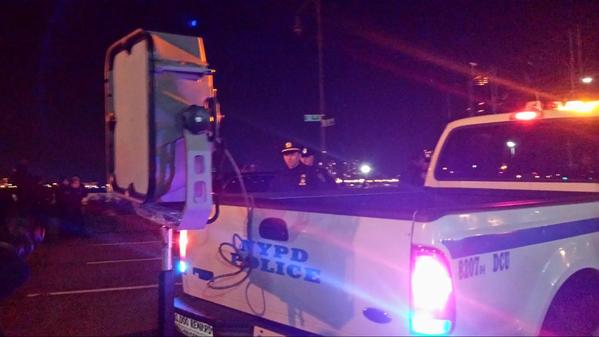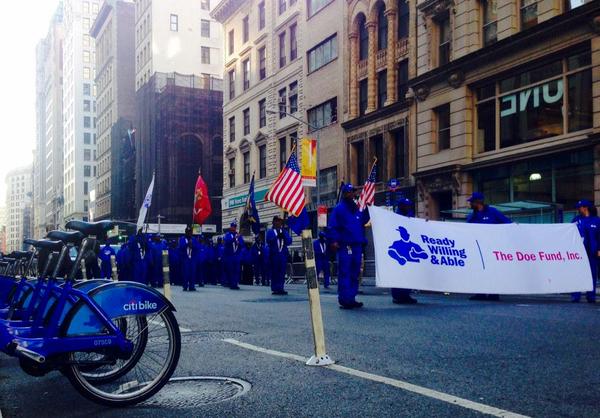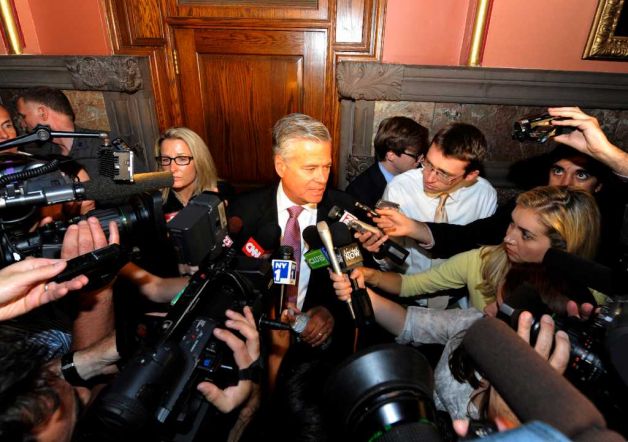What's the NYPD doing with an LRAD?

An LRAD being used by NYPD on Dec 3 (photo: @PeoplesHistory)
While the protests following the non-indictments in Ferguson and Staten Island have been disruptive, they have been mostly non-violent and clashes with police have been minimal, with the notable exception of the injury of two NYPD officers on the Brooklyn Bridge on the night of December 13.
However, on December 5 officers attempted to disperse a small march in Midtown using a new tool in crowd management, a long range acoustic device (LRAD).
LRADs have two primary functions: first as a long range communication device and second as a dispersal tool, emitting penetrating and piercing tones at high decibels.
LRADs were developed for the military following the terrorist attack on the USS Cole in October 2000 in Yemen. The purpose of the device was to ward off potential attackers before they could get close enough to an intended target to strike. The device has also been used at military checkpoints to communicate with and deter threatening vehicles.
The use of LRADs as a speaker may have some justification in crowd control. Best policing practices call for enhanced communication between demonstrators and the police. While this should be done face to face and on the ground as much as possible, there are situations where the police should notify crowds of their risk of arrest or of being subjected to use of force. Such crowds should be told where to disperse to and how. LRADs might be able to help with this since they can be heard over the shouts of crowds, unlike many conventional sound systems. However, we don't really know what if any harmful effects this function might produce, especially for people with existing hearing problems.
The dispersal function is similar to tear gas or water cannons. It is intended to be a less lethal use of force that can be used as an alternative to baton charges or other more extreme measures. Their use might be appropriate in dealing with a violent crowd attempting to storm the UN or other location where force might be necessary to prevent property destruction or injury. The effect, however, is usually rather crude. Like with tear gas, flash bang grenades, and riot control projectiles, the dispersal brought about by LRADs generally is disorderly and can lead to collateral property destruction and injury to onlookers and innocent by-standers. They should be used only as a last resort, in place of relying on higher levels of force.
The question of whether an LRAD is preferable to tear gas, projectiles, or flash bangs depends on balancing effectiveness in reducing violence and property destruction versus potential injury to protesters and onlookers. The problem is that we don't have very good evidence about the potential harmful effects of this relatively new and untested technology. There have been reports of related injuries leading to a legal settlement from LRAD use in Pittsburgh in 2009 and a ministerial report in Canada raised significant concerns about their health effects.
If we knew for sure that the dispersal function had no long term health consequences, then it might be preferable. If, however, there is a risk that those with existing hearing problems, and even others might experience medium to long term problems, or if psychological or cognitive functions are disrupted, then the costs may be too high. In the absence of clear evidence we should err on the side of caution.
One of my major concerns is that like with tasers and much military hardware, there is strong temptation for "mission creep." Often these devices are obtained under the pretext of very restricted uses in extreme and highly unlikely circumstances such as terrorist attacks or snipers. However, once departments have them, there is a tendency to use them in additional ways that make life easier for police but endanger the public.
Tasers can be life savers, but they can also be torture devices when used improperly. LRADs have this potential and we saw something like this when they were used during the Garner protests in New York. A few individuals in a larger group threw some things and the police used the dispersal function against the whole group on a Midtown street with no real plan for managing their dispersal. Other less dangerous methods could have been used and the effect on an already dispersed group was just to splinter them, making it harder for police to track them and leaving open the opportunity for random property destruction. Generally, this technology should not be used on a few troublemakers in an otherwise peaceful protest and it should not be used on more broadly violent crowds unless there are limited alternatives and a plan for managing an angry and disorganized splintering of the group.
Last week a group of lawyers sent a letter to the NYPD asking them to clarify their policies about the use of this technology. So far there has been no official response. There needs to be much greater transparency about the plans to use such intensive riot control tools. In fact, the NYPD also owns water cannons, and there has been no public discussion of their appropriate use either. It's time for the City Council to step in and hold hearings about the proper uses of riot control equipment in the New York.
***
Alex S. Vitale is associate professor of sociology at Brooklyn College and author of City of Disorder: How the Quality of Life Campaign Transformed New York Politics. He is senior policy adviser to hte Police Reform Organizing Project and serves on the New York State Advisory Committee to the US Civil Rights Commission. You can follow him on Twitter: @avitale
A Working Solution for Homelessness

Members of the Doe Fund march in the Veterans Day Parade (photo: @TheDoeFund)
In a December 11 Gotham Gazette editorial advocating for more supportive housing, a program director from the Goddard Riverside Community Center made a bold statement: "The number one cause of homelessness[...]is a lack of affordable housing." That's a clean explanation for one of society's most vexing problems, but it's not true.
If housing was the answer to homelessness, we would have solved this crisis a generation ago. Homelessness isn't a state of being; and it's not a condition that people must live with and manage, like diabetes or cancer. It's an outcome. In a small fraction of the cases, it's the result of a serious disability that precludes a person's ability to work. But to say that all—or even most— homeless people require subsidized housing implies that they as a "group" are incapable of supporting themselves. And that line of reasoning is offensive to advocates like me, who know this population and have served them for decades.
Permanent supportive housing is our responsibility to provide for people who are profoundly disabled. But it also requires enormous and unending support from taxpayers. What happens when programs change, budgets get cut, and the money runs out? The homeless people warehoused in supportive housing are back on the streets, without any of the tools they need to live independently. To make supportive housing possible and sustainable for those who really do need it, we need a strong city with a strong workforce.
Any way you slice it, the answer to both our growing homelessness crisis and our need to build supportive housing is work.
The city, the state—the nation as a whole— has to recognize the dignity and potential in our homeless and long-term unemployed populations. We need programs that address not just a bad outcome, like homelessness, but the complex web of barriers, behaviors, and circumstances that have produced it: education, skills and experience gaps, vocational training and workforce development, substance abuse treatment, and reentry support for the formerly incarcerated.
When my husband and I started our work thirty years ago, people told us there was no way to put the homeless to work. They were lost causes; they would never be able to support themselves. They were simply "too lazy, or too crazy."
We can all agree that that's a disgusting statement. But is it really so far from dismissing all homeless people as permanently disabled? I can think of at least 21,000 individuals who would beg to differ; they're just some of the people we've served over the last three decades. They didn't come to our organization for a free house. They came to us for an opportunity: to work, to grow, and to support themselves and their families—for life.
Ms. McCullough of Goddard Riverside is right: the measure of a society is how it treats its most vulnerable members. Let's start by recognizing their dignity and abilities. Then, let's give them the hand up they deserve, one that frees them from homelessness forever; not a handout that keeps them trapped, right where they are.
***
Harriet McDonald is the Executive Vice President of The Doe Fund, a nonprofit organization that provides transitional housing, paid work, job training, and supportive services for the formerly homeless and incarcerated. Find The Doe Fund on Twitter: @TheDoeFund
****
Have an op-ed idea or submission for Gotham Gazette? E-mail editor Ben Max: This email address is being protected from spambots. You need JavaScript enabled to view it.
The 2014 Republican Victory for New York State Senate: Impressive...and Fragile

Republican Senate leader Dean Skelos (photo: Skip Dickstein/Times Union)
The decisive GOP return to control of the New York State Senate has been attributed to many causes: disproportionate resources, clever campaign tactics, individual candidate strengths and frailties, the coattails of a nationwide "Republican sweep." All are plausibly contributory to this impressive Republican win. Most important, however, are these four structural and tactical factors: gerrymandering, a strikingly smaller electorate, selective voter drop-off among those who turned out, and systematic statewide inter-party coalition building.
New York did its typical bi-partisan gerrymander in 2010. Republicans designed the Senate districts; Democrats did those for the Assembly. Nonetheless, in 2012 there were a number of unexpected GOP losses in areas of rapid demographic change, for example the Hudson Valley. After his vote for same sex marriage, long time Dutchess County GOP veteran Senator Steve Saland was knocked out in a three way race. In a neighboring district across the Hudson, Democrat Cecilia Tkaczyk used late big-money backing to win by a hair's breadth. Republican victories this year in both of these same GOP designed districts might be regarded as "a return to gerrymandered normal."
The electorate was unexpectedly small. A smaller electorate favors Republicans, who are disproportionately in demographic groups that are more likely to vote. The reasons:
First, the usual: It was not a presidential year: Turnout in New York is always lower in the even numbered years in which we elect a Governor than in those in which we elect a President.
This said, turnout was a million votes lower in 2014 than in 2010, the previous gubernatorial year. Why?
There was an incumbent governor running, with little perceived competition. The top of the ticket race thus did not bring voters to the polls. Andrew Cuomo also benefitted from the deterrent effect of a massive political bank roll and a record that appealed to right-center voters. Though he ran a lively campaign, Rob Astorino, the Republican candidate for governor, suffered from the self-fulfilling prophecy problem. He was written off early and relentlessly by analysts as an under-funded sure loser.
Many normally Democrat voters were mad at the governor: disaffected government reformers and social-activist liberal Democrats to his left, public employees in the center.
Additional evidence that Democrats disproportionately did not vote is that low turnout was not evenly distributed across the state. About half the proportion of eligible voters in overwhelmingly Democrat New York City (21.1%) cast ballots compared to voters outside the city (42.6%).
Politics generally is in disrepute. A November, 2014 Pew Research Center report documented that trust in government continued at "historic lows." Stay-at-homes may not participate because "voting 'just encourages them.'"
Add in another usual pattern, down-ticket voter drop-off. About 10% of the people who came out to vote cast no ballot in a Senate election. We can't tell what party each of these 381,000 voters might have favored, but we know that these down-ticket dropouts lived disproportionately in Long Island and upstate districts that elected Republican Senators.
All this resulted in a Republican total for Senate candidates (1,355,591) about 175,000 greater than Rob Astorino's for Governor, and just 26,385 fewer than cast for all Senate Democrat candidates in this dark blue state.
Then there's what New York pols call "the cross." Cross-endorsed candidates for office in New York may run on multiple party "lines." While much attention focused on whether the Republican/Independent Democrat (IDC) coalition would persist following the election, there was little given to the systematic pre-election coalition that the Republican Senate campaign effort cemented with the Conservative and Independence parties. The Republicans wrote off 15 Senate districts entirely (13 in NYC), and had mere token candidacies in at least another seven. This left 41; in 34 of these GOP candidates, whether challenged or not, had both the Conservative and Independence Party ballot lines. With few exceptions, Democrats with the Independence line were either unchallenged or IDC members.
The total Conservative vote in Senate races (251,103) exceeded that on this line for the race for Governor. The Independence total for Senate contests (185,427) was more than double that for Andrew Cuomo at the top of the ticket, even after removing Mark Grisanti's 21,826 votes in the unusual four-way contest in Erie County's Senate District 60. Almost all of these third party votes went to Republican Senate candidates.
Focus on these particulars brings into question any prediction of an incipient GOP resurgence in New York State politics. Many senior Republican Senators are aging; so are many of those who voted for them. Republican Senate candidates got clear majorities of those that turned out in fewer than half the districts they won (15 of 32) and in nine of these there was no Democrat on the ballot. If patterns hold, as they likely will, the 2016 New York electorate will be about two million or more voters bigger than that of 2014. And specific circumstances in the presidential race - e.g. a Hillary Clinton candidacy - may drive the New York participation up even further. Cross endorsement is volatile, and sometimes two edged. The base of GOP power in New York State government is still most fragile. If the GOP planning to protect its win did not begin on the morning of November 5, 2014 (the day after Election Day), it started too late.
***
Gerald Benjamin, Distinguished Professor of Political Science, is director of the Center for Research Regional Engagement and Outreach at SUNY New Paltz (CRREO).
Sadie Godlis, a major in Political Science, is a student researcher at CRREO.
***
Have an op-ed idea or submission for Gotham Gazette? E-mail editor Ben Max: This email address is being protected from spambots. You need JavaScript enabled to view it.




